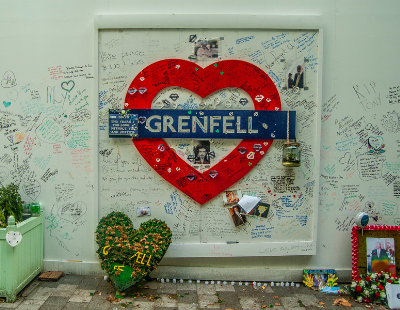Some fear that without government help, and a commitment that they should not be responsible for rebuilding costs, they face possible bankruptcy.
In the latest figures available from the Building Safety Data service, 90% (417) of all identified high-rise residential and publicly owned buildings in England had either completed or started remediation work to remove and replace unsafe Aluminium Composite Material (ACM) cladding.
But the EWS scheme of professional assessment of building safety has led to confusion, with changes to government guidance in January 2020 meaning that buildings lower than 18m also potentially needed a safety assessment before leaseholders could sell.
Since April, buildings of four storeys or fewer will not require an EWS1 form, even if they have cladding and balconies. The exception is if they have the most flammable types of cladding, which are aluminium composite material (ACM), metal composite material (MCM) or high-pressure laminate (HPL).
Robert Jenrick, the Housing Secretary, said the new guidance will mean 500,000 fewer leaseholders need an EWS1 form, but some homeowners and fire safety experts are not entirely convinced.
In February 2021, Jenrick pledged an extra £3.5 billion to the Building Safety Fund to remove any dangerous cladding on blocks taller than 18m, and to provide loans to leaseholders for buildings between 11m and 18m in height, or four to six storeys tall. Leaseholders would pay back the loans through their service charge, but these will be capped at £50 per week.
Mr Jenrick described this as an 'exceptional intervention’ and said that the government was taking a 'safety-led approach’ and aiming ‘to end the cladding scandal in a way that is fair and generous to leaseholders’.
However, the passing of the Fire Safety Bill in May with no provision to exempt leaseholders from paying for remedial work means that thousands are still uncertain about their position.
Stephanie Lamb, 32, an advertising executive, lives in an eight-storey block with flammable cladding which is eligible for the £5 billion government fund. But it has other safety defects which are not covered, such as combustible insulation and missing fire-breaks.
As a result, Stephanie faces an anxious wait to see if her block will receive vital cash from the cladding funds replacement fund. If this funding is not received, then the total repair bill could come to around £50,000 per flat.
Stephanie, of Croydon, said: “Leaseholders have been left in the dark and we can’t even prepare for how much this might cost us. I don’t know how they expect us to pay for the kinds of bills that are being talked about.”
Her housing association, Clarion, was initially reluctant to apply for funding, as it realised that non-cladding defects would not be covered. Clarion said that it was ‘working to ensure that repairs were done as quickly as possible’.
Rhiannon Creasey, who holds a lease on a property which is part of the Emirates Stadium development in North London, was warned of a potential £4.73 million bill to mediate fire safety defects on the building, and says that her life has been ‘put on hold’, with the lingering threat of expenses of £50,000 hanging over her for almost a year.
Arsenal FC‘s parent firm told leaseholders at 1 and 3 Queensland Road and Highbury Square in London that their flats needed remediation work. Highbury Square is located on the club’s former ground, and Queensland Road is next to Arsenal‘s Emirates Stadium.
Built by a housing trust on Arsenal land, the Queensland complex has 110 flats, a community hub and access to underground parking for players. When it failed safety checks, ex-Labour leader Jeremy Corbyn, local MP and an Arsenal fan, said: “The residents should not bear the costs here.”
Arsenal, meanwhile, commented: “We take health and safety extremely seriously. We pay market rates and recharge to leaseholders. This is standard practice.”
According to sports website The Athletic, the total costs to make the sites safe could be above £10 million, with residents on Queensland Road told they could each be asked to pay £50,000, and Highbury residents liable for £36,000 each.
In the short term, insurance charges have gone up, in Rhiannon Creasey’s case from £310 to £673, an increase she describes as absurd. “It hurts,” she said. “A club with all the riches in the world passing on soaring insurance.”
But in some cases, the original developers of unsafe buildings no longer exist, and those that do are understandably reluctant to pay the costs of remediating their work. Referring to a Lambeth Housing estate, a spokeswoman for Barratt Homes said it ‘appreciates how concerning the difficulties facing leaseholders and residents are’.
“The development was built in 2009 and signed off as meeting the requirements of building regulations by an independent approved inspector at the time of construction,” she added.
“However, while we have no legal liability, we do take our responsibilities as the original developer very seriously.”
“We have been working to assess and understand the issues at the development and are committed to working with the managing agent and freeholder to help them find a suitable solution for leaseholders and residents,” she said.
As a tower block fire at New Providence Wharf in May underlined the dangers of combustible external cladding, pressure groups such as UK Cladding ActionGroup (UKCAG) describe the government’s £3.5 billion fund as ‘too little, too late’, and continue to push for an end to what they describe as the ‘cladding scandal’.
As a result of this, many leaseholders in cladded blocks have struggled to sell their properties. The high service charges and risks of further significant bills for remedial works combined with many of the flats being unmortgageable have left many, of the up to 11 million people, living in properties with unsafe cladding unable to sell their property.
As James Currie, who lives in Manchester, told the Guardian: “We don’t know when a bill will arrive, what it may look like and how we will be asked to pay it…We really want to move, especially as we don’t want our daughter to live on a building site, but we can’t sell to anybody who needs a mortgage and the estate agents say we’d have to take a big cut to the price to cover the risk a buyer was taking on.”
This has led to many, in cladded blocks, looking to sell their homes to buyers who aren’t reliant on mortgages. Cash property buying firms can purchase without a mortgage and specialise in buying properties in cladded blocks.
*A version of this article previously appeared on the website of Sell House Quick Now (SHQN)
*Jay Howard is SHQN's trusted property expert and has 18 years of experience dealing with all aspects of property sales and purchases
**Since publication of this article, the Ministry of Housing, Communities & Local Government has been in touch with the following response.
It said it’s important to note ‘EWS1 forms are not government forms or policy’. A note from MHCLG explained. “We don't mandate them. And the new guidance referred to is from RICS, which owns the policy on EWS1.”
An MHCLG spokesperson added: “We understand many people are worried - we’re protecting those in buildings between 11m-18m from unaffordable costs, ensuring no leaseholder will pay more than £50 a month to remove unsafe cladding. This is on top of the more than £5 billion to fully fund the replacement of unsafe cladding in highest risk buildings.”
“We have been clear building owners should make their buildings safe without passing on costs to leaseholders - and we will ensure the industry pays its fair share towards the costs of cladding remediation through a new levy and tax.”








/MichaelGove-400x310.jpg)




.png)


.png)



Join the conversation
Be the first to comment (please use the comment box below)
Please login to comment